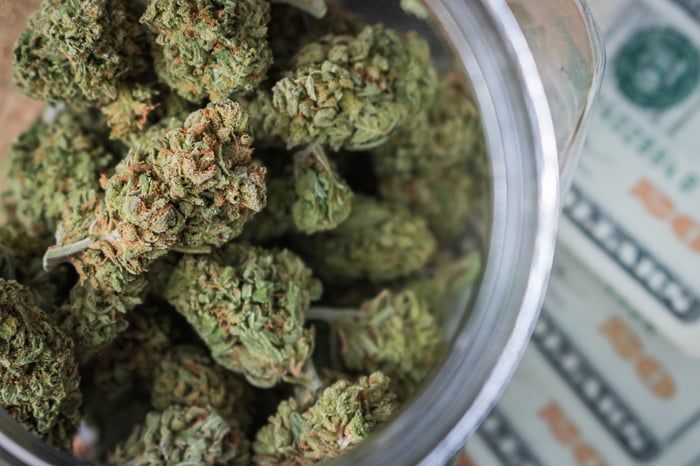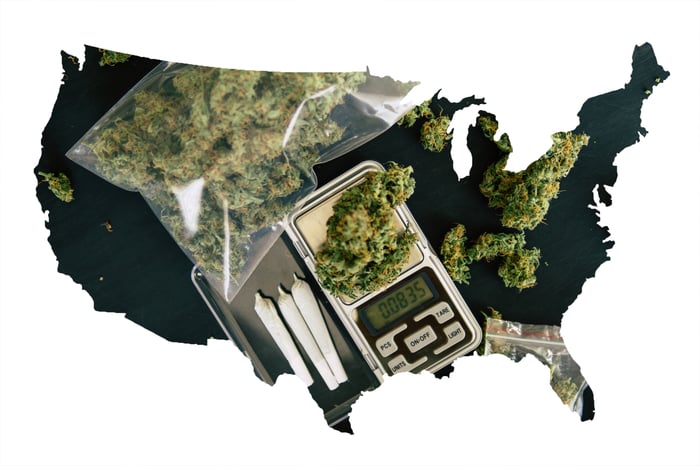Having long been considered a taboo industry, cannabis is no longer. Last year, Canada became the first industrialized country in the world to legalize recreational weed, and just weeks later a handful of U.S. states gave the green light to medical or adult-use pot during midterm elections. Today, two-thirds of U.S. states have approved marijuana in some capacity, with 66% of respondents polled in Gallup's October 2018 survey favoring the idea of legalizing marijuana.
As the cannabis industry sprouts, investors have taken notice. Last month, 15 pot stocks rallied by at least 50%, with many of the largest marijuana stocks up by a high-triple-digit or quadruple-digit percentage since 2016 began.
But with these monstrous gains, we have to ask: How big could the marijuana industry actually be?

Image source: Getty Images.
Three lofty global sales estimates for the weed industry
Right now, there are three pretty lofty estimates from industry pundits and Wall Street analysts. The first comes courtesy of a co-authored report "2019 Update to the State of Legal Marijuana Markets," from Arcview Market Research and BDS Analytics. After delivering $6.9 billion in global sales in 2016, $9.5 billion in worldwide revenue in 2017, and an estimated $12.2 billion last year, global sales are expected to grow 38% in 2019 to $16.9 billion, and hit $31.3 billion by 2022. That's a compound annual growth rate of 26.7% between 2017 and 2022.
A second lofty estimate comes from Cowen Group sector analyst Vivien Azer. In September 2016, Azer and her team released a 110-page report, "The Cannabis Compendium: Cross-Sector Views on a Budding Industry," that outlined a trajectory to $50 billion in global sales by 2026. However, in April 2018, Azer updated Cowen's outlook for the cannabis industry by increasing its forecast to $75 billion in global sales by 2030. According to Cowen, the global pot industry is already worth $50 billion, inclusive of black market channels. Factoring in per-capita spending of $1,500 a year and 35 million annual pot users, $75 billion in global weed sales appears reasonable.
The third estimate, which came out this past week, is courtesy of Wall Street investment bank Jefferies and covering analyst Owen Bennett. Per Bennett, the global cannabis market, which includes sales estimates for 22 countries, should grow from $17 billion in 2019 to $50 billion by 2029, closely matching Cowen's initial estimate for 2026. Bennett's research note suggests that $19 billion of this will be derived from the medical marijuana market, with $31 billion in worldwide revenue coming from adult-use pot.
However -- and this is a pretty big "however" -- Bennett believes the global cannabis industry has the potential to grow to $130 billion in annual sales. That would mean the weed industry could practically double up the soda industry in about a decade, and may give the alcohol industry a run for its money, depending on whether consumers trade off alcohol consumption in favor of cannabis use.

Image source: Getty Images.
What could go wrong?
While there's certainly a path to rapid sales growth, not even the marijuana industry is impervious to "hiccups" and speed bumps. Here a few things that could go wrong and keep the industry from reaching these lofty estimates.
1. Cannabis taxes could drive consumers back to illicit channels
The first concern is the taxation of recreational marijuana sales which, as noted, should represent a clear majority of global revenue in the decade to come. California, the fifth largest economy in the world by gross domestic product, has imposed a 15% excise tax, a cultivation tax on growers of $9.25 per ounce of cannabis flower, or $2.75 per ounce of cannabis leaves, and state and local taxes. Add this up, and some locales could be paying as much as 45% in aggregate tax on adult-use cannabis, which could wind up sending legal consumers back to illicit channels.
Remember, black market marijuana growers don't have to wait for cultivation and processing licenses or sales permits. They also won't be paying state income tax, federal income tax, or the cultivation and excise taxes imposed in the state. Illicit weed will easily undercut the Golden State's legal pot industry on price, and first-year tax revenue collection figures show this to be true. Having originally expected $643 million in full-year 2018 sales following the sale of adult-use weed in dispensaries, actual collection totaled just $345.2 million last year. If U.S. states or foreign markets fail to tax cannabis appropriately, it could seriously reduce the industry's potential.
California's problems are of particular concern to Origin House (ORHOF), which has bet big on being a distribution kingpin in the state. Origin House has been gobbling up some of the smaller pot distributors in California, thereby nabbing the few distribution licenses outstanding. But if consumers aren't actively staying within legal channels, then rampant oversupply and reduced demand could sap Origin House's potential, at least over the next couple of years.

Image source: Getty Images.
2. Legalizations in key markets are no guarantee
Second, these sales expectations assume that numerous countries will legalize weed in the intermediate future. However, this isn't a guarantee. Even with two-thirds of the U.S. population in favor of legalization, there are countless obstacles that'll prevent marijuana from getting the green light in the U.S. in the near term. For instance, Republicans have a generally poor view of marijuana, and since they control the Senate and presidency, no legalization appears likely before at least 2021.
Building on this point, legalizing marijuana in the U.S. would create revenue issues for the federal government. Currently subjected to Section 280E of the U.S. tax code, pot-based businesses are disallowed from taking normal corporate income tax deductions, save for cost of goods sold. This leads to high effective tax rates and much needed revenue for the federal government. Legalizing weed would no longer mean subjecting the industry to 280E, which would cost the federal government an estimated $5 billion in revenue over a 10-year period.
3. Regulatory red tape can cause problems
Even regulatory red tape in a legal environment could lead to problems. In Canada, regulatory agency Health Canada is contending with a monstrous backlog of cultivation licenses and sales permits. These sales permits were taking the agency an average of almost one year to approve, as of May 2018. Even when demand exists, regulatory red tape could keep the cannabis supply chain from realizing its full potential.
We've also witnessed this in action, with sales projections for Canopy Growth (CGC -10.50%), the largest pot stock in the world, falling dramatically. Although Wall Street sales estimates are pretty few and far between in the early going, Canopy's top-line consensus before its third quarter report were slashed by roughly 40% in lieu of cannabis shortages and regulatory issues in Canada. Mind you, this doesn't Canopy Growth won't be successful going forward. However, it does suggest that sales growth expectations may not be achievable in the near term.
Make no mistake about it: The marijuana industry will be huge, and it's here to stay. But also understand that it won't be a risk-free ride to riches.
Check out the latest earnings call transcript for Canopy Growth.




